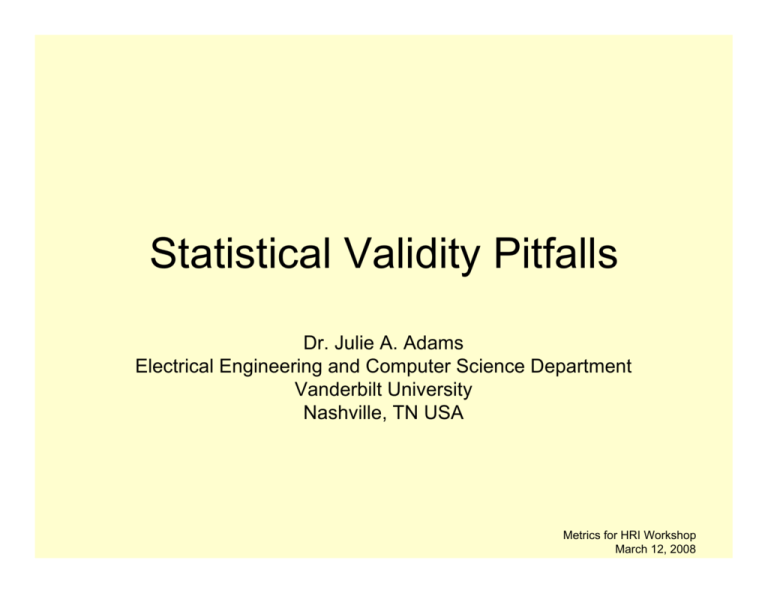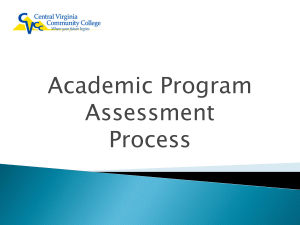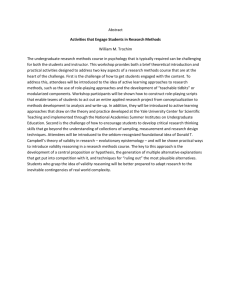
Statistical Validity Pitfalls
Dr. Julie A. Adams
Electrical Engineering and Computer Science Department
Vanderbilt University
Nashville, TN USA
Metrics for HRI Workshop
March 12, 2008
Garbage In, Garbage Out!
Metrics for HRI Workshop
March 12, 2008
Evaluation Validity
• Evaluation validity is concerned with the
correspondence between how
representative the evaluation results are of
how the evaluated activities will be
performed in the real world.
– “What is true about behavior for one time and
place may not be universally true” (Maxwell
and Delaney, 2004)
Metrics for HRI Workshop
March 12, 2008
Types of validity
•
•
•
•
Statistical conclusion validity
Internal validity
Construct validity
External validity
Metrics for HRI Workshop
March 12, 2008
Statistical Conclusion Validity
– “was the original statistical inference correct?”
• Did the investigators arrive at the correct
conclusion regarding whether or not a relationship
between the variables exists or the extent of the
relationship?
• Not concerned with the causal relationship
between variables, but whether or not there is any
relationship, either causal or not.
Metrics for HRI Workshop
March 12, 2008
Statistical Conclusion Validity
– Type I Error
• Conclude that a relationship exists between two
variables, when in fact there is no relationship.
– Type II Error
• Conclude that there is no relationship when one
exists.
– The power of the analysis focuses on the
sensitivity or ability to detect a relationship.
Metrics for HRI Workshop
March 12, 2008
Statistical Conclusion Validity
• Threats to statistical validity
– Liberal biases: being overly optimistic
regarding the existence of a relationship or
exaggerating its strength.
– Conservative biases: being overly pessimistic
regarding the absence of a relationship or
underestimating its strength.
– Low power: the probability that the evaluation
will result in a Type II error.
Metrics for HRI Workshop
March 12, 2008
Statistical Conclusion Validity
• Threats to statistical validity
Threats leading to overly conservative bias
Remedies
Small sample size
Increase sample size
Increased error from irrelevant, unreliable, or invalid
measures
Improve measurements
High variability due to participant diversity
Control individual differences: control for covariates;
using a design that blocks, matches, or uses
repeated measures.
Violation of statistical assumptions
Transform data or use different analysis methods.
Threats leading to overly liberal bias
Repeated statistical test
Use adjusted test procedures
Violation of statistical assumptions
Transform data or use different analysis methods
Biased estimates of effects
Use corrected values to estimate effects in
population
(Maxwell and Delaney, 2004)
Metrics for HRI Workshop
March 12, 2008
Internal Validity
• “Is there a causal relationship between
variable X and variable Y, regardless of what
X and Y are theoretically supposed to
represent?”
– If a variable is a true independent variable and
the statistical conclusion is valid, then internal
validity is largely assured.
– The concern of internal validity is causal in that
we are asking what is responsible for the change
in the dependent variable.
Metrics for HRI Workshop
March 12, 2008
Internal Validity Threats
Threats
Definition
Selection Bias
Participant characteristics confounded with treatment conditions because
of use of intact or self-selected participants, or more generally, whenever
predictor variables represent measured characteristics as opposed to
independently manipulated treatments.
Attrition
Differential drop out across conditions at one or more time points that
may be responsible for differences.
Testing
Altered performance as a result of a prior measure or assessment
instead of the assigned conditions.
Regression
The changes over time expected in the performance of participants,
selected because of extreme scores on a variable, that occur for
statistical reasons but may incorrectly be attributed to the intervening
condition.
Maturation
Observed changes as a result of ongoing, naturally occurring processes
rather than condition effects.
History
Events, in addition to an assigned condition, to which participants are
exposed between repeated measurements that could influence
performance.
(Maxwell and Delaney, 2004)
Metrics for HRI Workshop
March 12, 2008
Construct Validity
• “Given there is a valid causal relationship, is the
interpretation of the constructs involved in that
relationship correct?”
• The problem: there is a possibility “that the
operations which are meant to represent a
particular cause or effect construct can be
construed in terms of more than one construct,
each of which is stated at the same level of
reduction.”
(Maxwell and Delaney, 2004)
Metrics for HRI Workshop
March 12, 2008
Construct Validity Threats
•
•
•
•
•
Experimenter bias: The experimenter transfers expectations to the
participants in a manner that affects performance for dependent
variables.
Condition diffusion: The possibility of communication between
participants from different condition groups during the evaluation.
Resentful demoralization: A group that is receiving nothing finds out that
a condition (treatment) that others are receiving is effective.
Inadequate preoperational explication: The construct under
consideration does not asses what you want and incorporates similar
constructs that should be distinguished from the desired construct.
Mono-operation bias: The use of only a single dependent variable to
assess a construct may result in under representing the construct and
containing irrelevancies.
Metrics for HRI Workshop
March 12, 2008
External Validity
• “Can the finding be generalized across
populations, settings, or time?”
– A primary concern is the heterogeneity and
representativeness of the evaluation sample
population.
Metrics for HRI Workshop
March 12, 2008
Garbage In, Garbage Out!
Metrics for HRI Workshop
March 12, 2008
References
•
•
•
•
•
•
•
V. J. Gawron, (2000). Human Performance Measures Handbook,
Lawrence Erlbaum Associates
R. J. Grissom & J. J. Kim (2005) Effect Sizes for Research,
Lawrence Erlbaum Associates
S. E. Maxwell & H. D. Delaney (2004) Designing Experiments and
Analyzing Data: A model comparison perspective, Second Edition,
Lawrence Erlbaum Associates
J. L. Myers & A. D. Well (2003) Research Design and Statistical
Analysis, Second Edition, Lawrence Erlbaum Associates
K. R. Murphy & B. Myors (2004) Statistical Power Analysis, Second
Edition, Lawrence Erlbaum Associates
J. Nielsen, (1993). Usability Engineering. Morgan Kauffman
C. D. Wickens, J. D. Lee, Y. Liu, S. E. Gordon Becker, (2004) An
Introduction to Human Factors Engineering, Second Edition,
Pearson/Prentice Hall.
Metrics for HRI Workshop
March 12, 2008







